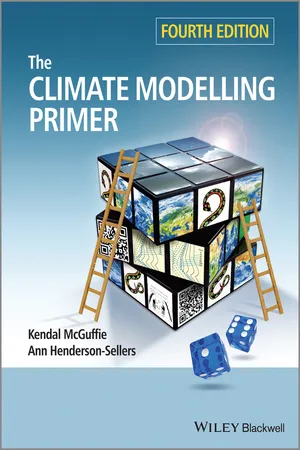
- English
- ePUB (mobile friendly)
- Available on iOS & Android
The Climate Modelling Primer
About this book
A thoroughly revised and updated edition, this book will assist the reader in understanding the complexities and applicabilities of today's wide range of climate models. Topics covered include the latest techniques for modelling the coupled biosphere-ocean-atmosphere system, information on current practical aspects of climate modelling and ways to evaluate and exploit the results, discussion of Earth System Models of Intermediate Complexity (EMICs), and interactive exercises based on Energy Balance Model (EBM) and the Daisyworld model. Source codes and results from a range of model types allows readers to make their own climate simulations and to view the results of the latest high resolution models. Now in full colour throughout and with the addition of cartoons to enhance student understanding the new edition of this successful textbook enables the student to tackle the difficult subject of climate modeling.
Frequently asked questions
- Essential is ideal for learners and professionals who enjoy exploring a wide range of subjects. Access the Essential Library with 800,000+ trusted titles and best-sellers across business, personal growth, and the humanities. Includes unlimited reading time and Standard Read Aloud voice.
- Complete: Perfect for advanced learners and researchers needing full, unrestricted access. Unlock 1.4M+ books across hundreds of subjects, including academic and specialized titles. The Complete Plan also includes advanced features like Premium Read Aloud and Research Assistant.
Please note we cannot support devices running on iOS 13 and Android 7 or earlier. Learn more about using the app.
Information
1
Why Model Climate?
- recognise the many reasons for having models
- track the history of climate theory becoming fact
- list the factors affecting planetary scale climate
- explain the concept of climate feedback and give examples
- recognise the mechanisms whereby persistent and widespread life affects climate.
1.1 Introduction
- A is for astronomy: any planet or moon with a climate is constrained by fundamental astrophysical conditions.
- B is for boundary and for biology: climate becomes interesting to model most often when it relates to living systems and where it touches boundaries.
- C is for comprehension: the reasons for constructing, operating and analysing climate models are ultimately to try to understand climate change and variability.
| A, B, C | Aspects of climate modelling |
| A: Astronomy | Astrophysical attributes – orbit, atmosphere, radiative budget, existence/prevalence of water … |
| B: Biology and boundaries | Life and climate, surface conditions, volcanic activity … |
| C: Comprehension | Prediction, testing theories, raising questions, bracketing outcomes, directing data collection, disciplining policy … |

| Type | Old chest | Authors’ treasure collection |
| Visual | Paintings | The cartoon by Cathy Wilcox illustrating the CMP authors’ research on Amazonian deforestation that was published on the front page of our local newspaper |
| Personal experience | Butterflies, beetles, etc. | Results from the Model Evaluation Consortium for Climate Assessment intercomparisons created in 1992. These were probably the first global climate model intercomparisons (e.g. videos on CD in CMP2) |
| Oceans | Algae and seaweeds | Movie featuring the ocean near where we live – ‘Finding Nemo’ (2003 and in 3D in 2012), especially for its depiction of the East Australian Current – the one that carries the turtles |
| Change behaviour | Exotic stuffed birds | Photos from visits to the melting Mont Blanc glacier when the authors lived in Geneva |
| Pretty things | Arrangements of sea-shells | Art work on the cover of The Future of the World’s Climate, a book the CMP authors edited in 2011–12. Both the art itself and the quotation it contains |
| How it works | Artefacts | An antiquarian water band spectroscope that KMcG bought for AH-S’s birthday that shows water vapour absorption bands (an in-your-hand greenhouse demonstrator) |
1.2 What is a climate model?
Table of contents
- COVER
- TITLE PAGE
- COPYRIGHT PAGE
- PREFACE
- ACKNOWLEDGEMENTS
- ABOUT THE COMPANION WEBSITE
- 1 Why Model Climate?
- 2 The Evolution of Climate Models
- 3 Energy Balance Models
- 4 Intermediate Complexity Models
- 5 Coupled Climate System Models
- 6 Through the Looking Glass
- COLLECTED ENDNOTES
- HINTS AND SOLUTIONS
- LIST OF ABBREVIATIONS
- LIST OF SYMBOLS
- BIBLIOGRAPHY
- INDEX